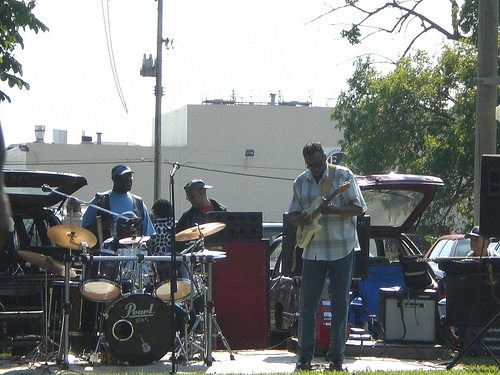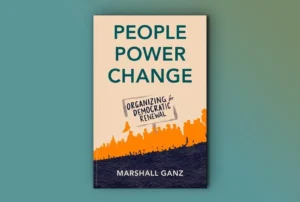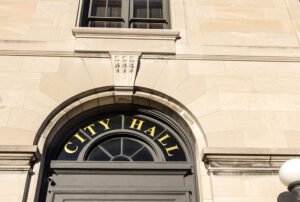
The Google Street View for 2133 Frederick Street in Detroit, Michigan, reveals what seems to be a typical scene in the heart of that beleaguered city, namely, utter desolation. Not a house in sight. Patches of old driveways and sidewalks, and crumbling street curbs.
But if you look at bit closer, you’ll notice something else. No trash. The empty lots in the foreground are neatly mowed. And there’s a makeshift stage in the corner of one of the lots. For this is the site of John’s Carpet House and Pete’s Place, where for the past 15 years “Mardi Gras in the ’Hood” has sprung to life every summer Sunday between 3:30 pm and dusk.
Danny Fenster, a grad student in Wayne State University’s English Department and a fan of the Detroit blues featured at the Carpet House, lovingly blogs about this “institution on the east side, a weekly display of vibrant, thriving life in an otherwise seemingly desolate area.” (His pieces appear regularly on the website Deadline Detroit, another scrappy survivor of the city’s hard times.)
Fenster notes that the Sunday tradition began when John Estes lived at 2133 Frederick. Estes was a junkman by profession, but by avocation a drummer and blues lover. He built a wooden shed in front of his house, padded it with carpeting for acoustical purposes (hence “John’s Carpet House”), and put on weekly jam sessions for the neighbors, who watched from across the street.
After John died, his house quickly went the way of all abandoned structures in Detroit and burned down. But Pete Barrow, a fellow blues lover, revived the tradition of weekly jam sessions in the now-vacant lots at the intersection of Frederick and St. Aubin (hence “Pete’s Place”). Soon, hundreds of people were gathering to hear live performances, along with Barrow providing DJ services from his vast collection of blues CDs.
“Famous names from Motown and soul music’s past and present have been known to show, including Smokey Robinson and members of the Contours and Romantics,” Fenster notes. The events were free, though Barrow passed the basket every Sunday—with the admonition to “put some ducats in the bucket”—to buy gasoline for the generator, keep the grass mowed, and, after the portable toilet was stolen, to buy a new one. Along with canopies, blankets, and lawn chairs, people began bringing grills, with some selling burgers, ribs, and sausages.
“Nobody is a stranger here,” Fenster quotes one patron. “Everybody here is family. If you’re hungry, somebody’s gonna feed you; if you’re thirsty, somebody’s going to give you something to drink. Whatever you need.” In spite of no security presence and just a few rules—“no drugs, no time,” read one of Estes’s signs—this ad hoc and diverse community in the heart of one of the nation’s most violent cities has rematerialized every clement weekend for fifteen years without incident.
Ironically, the only threat to this scarce and desperately needed stirring of civic energy has been posed by officials of the city of Detroit. Some years ago, the police tried to shut it down, but they backed off after Barrow purchased the eight vacant lots where it occurred. He was led to believe, he insists, that as owner of the property his gatherings could now be considered private events.
But on a Sunday in late July, the police were back, and closed down the gathering. “They say we need an entertainer’s license—they ain’t never had that before. And they say the food vendors, they have permits but not licenses or something—I don’t know, they shut everybody down,” Barrow explained to Fenster in tones familiar to anyone who’s tried to navigate City Hall’s labyrinthine licensing and permitting processes.
Police promised to return by 5 pm to ticket any of the cars still parked in the area. This in a city where, until recently, it took 58 minutes for the police to respond to 911 calls, and where only 8.7 percent of crimes were solved. And in a neighborhood where, as the Google Street View suggests, parking irregularities aren’t likely to trouble residents, even if there were any.
As of August 3rd, the jams were back in session (food vendors were still banned), but given its history, it’s probably just a matter of time before the city moves against John’s Carpet House again. This will be bad news for those of us who are fans of civic institutions—not the towering, well-financed, professionally staffed nonprofits that are indistinguishable from government agencies or corporations, but the tiny, scruffy, all-but-invisible grassroots groups that assemble quietly (or with somewhat louder blues accompaniment) to build something that everyday citizens want in their own lives, in their own ways.
Robert Woodson (recently acclaimed and denounced for mentoring Congressman Paul Ryan in the problems of poverty) has insisted for decades that such groups spring up in the most unlikely places, after all other major agencies of business, government, and charity have fled. At a moment when we’re too inclined to regard voluntary activity as nothing more than the leisurely hours put in by the children of affluence in order to bolster their resumes, it’s useful to recall that for many Americans, volunteerism isn’t just a pleasantry or an afterthought. Rather, it’s the difference between flourishing and decline, the only way to pull themselves out of the despair so widespread in our central cities.
Nowhere has this proven to be truer than in Detroit. Far beneath all the high-flying financial wheeling and dealing now underway to pull it out of bankruptcy, and well outside the fortified enclaves along the riverfront that define the hip, high-tech “new Detroit” in the glossy magazines, everyday citizens have come together to make new lives for themselves in the face of decay so profound and so widely photographed that “ruin porn” has now entered our vocabulary.
For 25 years, Motor City Blight Busters has demolished or rehabilitated hundreds of houses and launched Angel’s Night, a countermeasure to the widespread arson spree that has marred Detroit’s Halloween for decades. Toni McIlwain’s Ravendale Community Center keeps civic agency alive in that hard-pressed neighborhood. The Heidelberg Project draws crowds from around the world to see its collection of quirkily decorated derelict structures. East Side Riders developed from an informal bicycle club into a neighborhood program for youngsters who are taught to decorate and maintain their bikes, which they use for community outings.
Last week, the Detroit Free Press ran a story about Dan Davis, who has converted the vacant lots around his house on Washburn Street into an outdoor movie theater for families and children, a playground, gym, and, across the street, a go-kart track, with 500 used tires stacked to provide bumpers around the track. “He’s like an icon around here. What he does for the neighborhood, people look up to him for it,” noted a friend.
And, of course, there’s John’s Carpet House. As Edward McClelland pointed out in Nothin’ but Blue Skies: the Heyday, Hard Times, and Hopes of America’s Heartland, “by showcasing African-American culture in a setting that was at once inner-city and pastoral, John’s Carpet House is not just quintessentially Detroit, it is uniquely Detroit. These blues, this barbecue, the empty fields, the cars…composed a scene that could not exist anywhere else in the world. Detroit is a great place to spend a summer vacation, if you know where to find the empty spots on its map.”
Sign up for our free newsletters
Subscribe to NPQ's newsletters to have our top stories delivered directly to your inbox.
By signing up, you agree to our privacy policy and terms of use, and to receive messages from NPQ and our partners.
Danny Fenster underlines the connection between these ventures and the larger cause of civil society: “The resilience of Detroiters and the DIY ethic the city has garnered and is lauded for exists in these sorts of efforts—the communal repurposing of the seemingly empty spots on the city’s map, the informal networks of musicians and artists and showspaces.”
How things will fare with the “empty spots on the map,” some of which are in fact not at all empty but brim with civic energy, may well determine the future of civil society in Detroit. For the problem is that the mainstream civic institutions in Detroit are clearly ambivalent about these DIY efforts. If the city has tried repeatedly to close down the Carpet House, one can only imagine what its hitherto somnolent bureaus will do now that the Free Press has disclosed the existence of an utterly unlicensed, unregistered, unregulated go-kart track built by a mere citizen out of old tires. The headline of the paper’s follow-up story—“Detroiter who shows love for his block gets love, donations in return”—is not likely to be echoed in the no-doubt-pending official health and safety investigations.
In the past, we might have written off the suppression of spontaneous civic activity as the inevitable result of modern organization. After all, isn’t the path of history away from amateur, do-it-yourself efforts toward professionalization and centralization, with the private and voluntary inevitably being displaced by the public and tax-subsidized? That argument has always been somewhat schematicized, along the lines of and related to the “secularization thesis,” according to which modern scientific rationality would inevitably drive out religious superstition. As theologian Harvey Cox noted in Fire from Heaven, that notion didn’t survive the rise of the Pentecostal Movement in distinctly modern early 20th-century Los Angeles from an obscure revival meeting on Azusa Street to a religious phenomenon gathering in billions of believers around the globe, and featuring its own great efflorescence of private, faith-based organizations.
At any rate, the example of Detroit suggests that the trend toward professional, publicly funded service provision may have its own historical trajectory, and not always toward bigger and better. Indeed, before the city can even think of providing once again even the most rudimentary functions of municipal government, it must work its way out from beneath a mountain of debt accumulated by overpriced public services rendered poorly often decades ago.
Having heard the siren call of a “Detroit Renaissance” many times before from the city’s elites, citizens out in the neighorhoods are unlikely to trust them now to include them in plans for the city’s future. This distrust is, of course, only reinforced by the energy the city is devoting to shutting off water to residents who are behind several months or several hundred dollars in payments while apparently ignoring vastly larger debts run up over years by public agencies and sports organizations. To embattled fans of the Carpet House, this must seem to be just further evidence of the downtown elite’s fortified enclave approach for building a “new Detroit,” while driving out the gritty, home-brewed institutions of the “old Detroit.”
Happily for grassroots civil society, though, new technologies allow everyday citizens to come together and resist the suppression of their DIY energies. Facebook provides a way for Pete Barrow to solicit donations for the Carpet House and to rally neighborhood support in the face of police hostility. Local grad student and blues lover Danny Fenster has kept the attentive public apprised of its plight through his blog. The indispensable website Deadline Detroit, itself struggling to stay afloat, hosts Fenster’s writing. NPQ has gotten in on the act through Rick Cohen’s fearless and thorough writing about the water cut-offs and the fate of the city’s non-elite institutions. Few of these stories about neighborhood civil society have engaged the mainstream media, which has devoted itself almost entirely to celebrating the influx of young, white creative hipsters to the riverfront redoubts carved out by local millionaires Dan Gilbert and Mike Illitch.
Sadly, the organizations that should be enthusiastically seeking out and supporting the wonderfully exuberant and diverse expressions of civil society—the city’s foundations—are engaged elsewhere. In the so-called “Grand Bargain,” they have committed hundreds of millions to the city’s public pension funds in order to save the Detroit Institute of Arts. While the DIA features a notable collection of art, every major city in the world can and does make the same claim for its museums. The expressions of culture that are uniquely Detroit’s, meanwhile, are ignored, or worse. One wonders, for instance, if some of the cruisers dispatched to silence the blues at the Carpet House weren’t among the scores of cars recently donated to the city by the major automakers.
Where millions have been required to bail out the DIA, and many more millions will be required to build an endowment sufficient to keep it going, it would take but a few thousand dollars to sustain the lives of the Carpet House, Blight Busters, the East Side Riders, and the informal media networks that feature and sustain their work. (To its credit, the Knight Foundation did in fact make a $10,000 grant last year to the Riders.)
For foundations that are enamored of results-driven grantmaking, it would be easy to measure the impact of a contribution to the Carpet House to replace its portable toilet, and maybe even add one or two. For foundation leaders who insist that they don’t just give money, but also leverage influence, a few calls to City Hall on behalf of Pete Barrow and his fellow civic leaders would no doubt work wonders. If foundations cannot act unless it be in pursuit of some grand strategic scheme, they can categorize these efforts under “renewing civic life,” a program title no less true for being rather grandiose.
Progressive foundations—and most of those active in Detroit fall under this heading—might use this occasion to attack the “structural racism” that some claim to be the target of their grantmaking. Insofar as they’ve focused on attracting young creative types to the city and saving the distinctly elitist Detroit Institute of Arts while ignoring homegrown expressions of African-American culture, progressive funders seem to have been manifesting rather than mitigating the characteristic behaviors associated with structural racism.
But the defense of grassroots civil society in Detroit is a cause that should engage conservative thinkers and donors as well. The “reform conservatism” enunciated in documents like the YG Network’s Room to Grow calls for a shift of responsibility for the poor to society’s “mediating structures,” social institutions like neighborhoods, houses of worship, and voluntary associations standing between the individual and the state.
Although conservatives may have in mind larger semi-private service providers like Catholic Charities, they must also, as Robert Woodson constantly reminds them, learn to locate, celebrate, and donate to groups like East Side Riders and Dan Davis’s go-kart track and outdoor movie theater. Woodson himself has long been a champion of Toni McIlwain’s work at Detroit’s Ravendale Community Center.
One of the precepts of reform conservatism is that low-income individuals are frequently blocked from worthwhile entrepreneurial activities by excessive licensing and regulation. The suppression of the vendors that had gathered around John’s Carpet House provides a perfect case study for this proposition and an opportunity for conservatives to showcase their concern for the poor.
I intend to send this appeal for assistance to acquaintances at Michigan’s preeminent conservative think tank, the Mackinac Center for Public Policy. I will also alert the Institute for Justice in Washington, D.C., which has made a name for itself defending street vendors and other low-income entrepreneurs against the oppressive burdens of regulation. I will be sure to report back to NPQ readers about any response.
Meanwhile, Danny Fenster noted to me that he will gladly convey anyone who wants to learn first-hand about John’s Carpet House to 2133 Frederick on any mutually agreeable Sunday afternoon this summer.
As Fenster notes, “Many [Detroit] communities have established their existence in the absence of a functioning city, and some are fearful that, as the city rebuilds its own capacity, it may knock down what its people have built in its place.” They’re of course right to be fearful. But it would be wonderful if, for once, the philanthropic sector so involved in the city’s future did its best to allay those fears, and came to the defense of civil society in the pure and raw form to be found on Frederick Street and elsewhere throughout Detroit.
William A. Schambra is director of Hudson Institute’s Bradley Center for Philanthropy and Civic Renewal.













